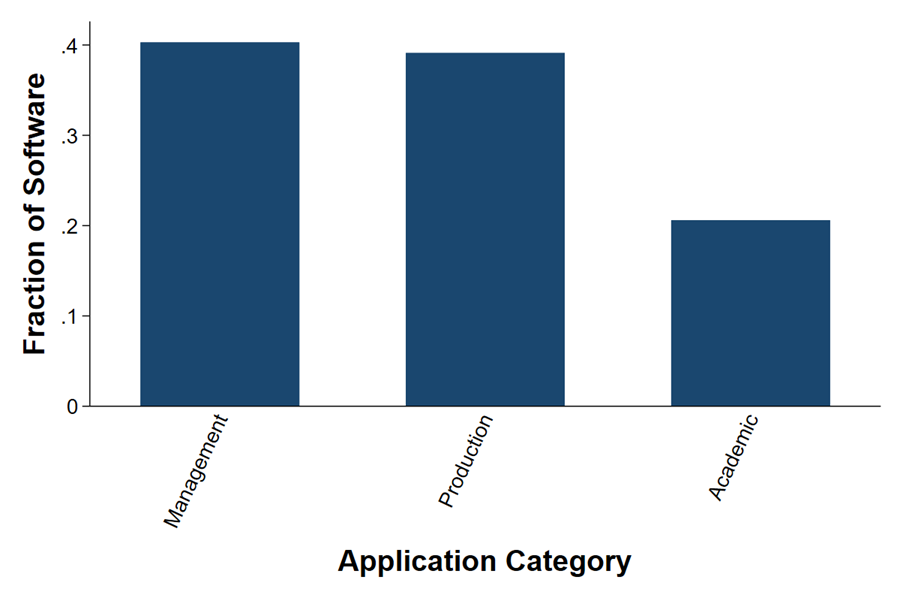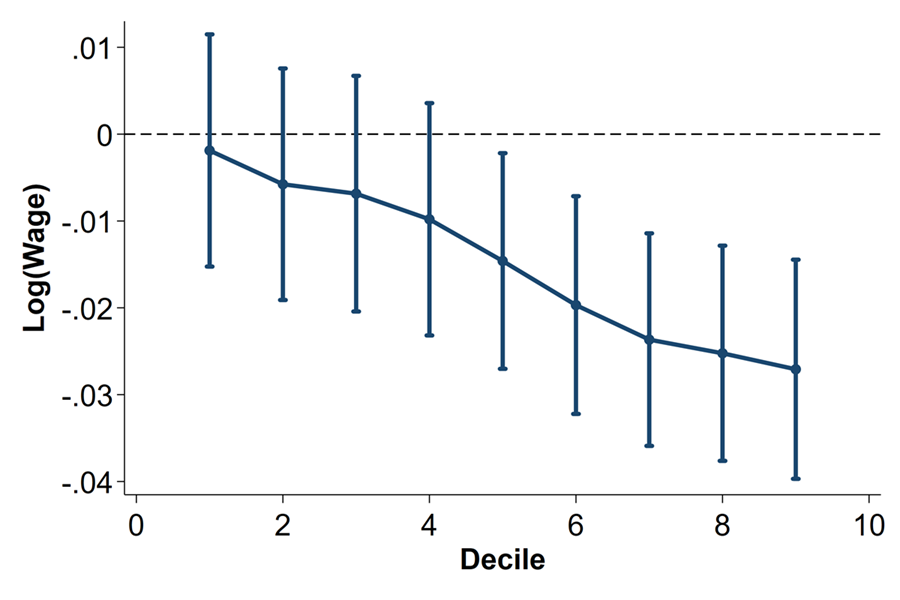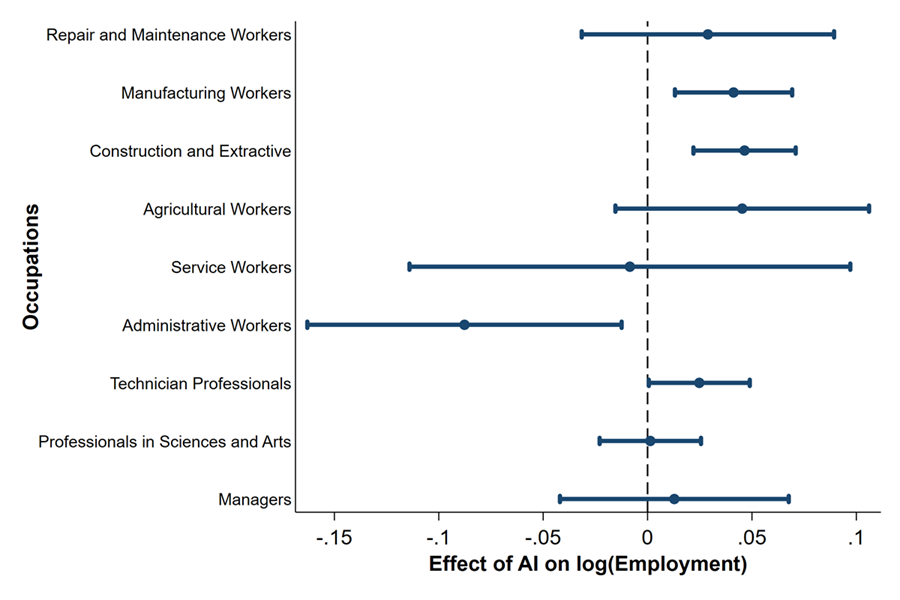Artificial intelligence (AI) now provokes intense public and academic debate. Some warn that AI will automate extensive areas of work, displacing millions of workers and increasing inequality (Acemoglu and Restrepo, 2019). Others contend that AI can enhance rather than replace human labor by simplifying complex machines and improving decision-making (Autor, 2024; and Agrawal et al., 2019). Which of these two forces dominates? That remains an open question, with relevant implications for policy and the future of work.
While recent attention has focused on generative AI, many current applications operate behind the scenes in core business functions, such as industrial automation (McElheran et al., 2025) or predictive maintenance (Alam et al., 2024), as well as in high-skill services, including healthcare and legal work (Gruber et al., 2020; and Choi and Schwarcz, 2025). Years before generative AI became widespread, Jeff Bezos, the CEO of Amazon, noted in 2017 that AI is “quietly but meaningfully improving core operations” (Lauder, 2017).
Brazil offers an unusually clean laboratory to study the effects of AI on the labor market, which I take advantage of in my recent research (de Souza, 2025). Thanks to Brazil’s particular intellectual property laws, its National Institute of Industrial Property (NIIP) records nearly every commercial AI program developed in the country since the 1980s. This unique data set reveals that AI is not limited to office tasks, such as those related to human resources (HR) or accounting. AI is also widely used in production, where it optimizes processes, runs quality control, and guides equipment operation. Because AI plays different roles in these two areas, it affects office and production workers differently. In the office, AI displaces routine tasks, reducing employment and wages. On the factory floor, AI makes machines more productive and easier to use, increasing the demand for low-education and younger workers to operate them. These findings suggest that as AI adoption continues to spread, governments should consider policies to help workers transition from administrative roles to production-related occupations.
To see how AI can increase factory jobs while replacing office workers, consider a real-world example: iMachine AI, a predictive maintenance system developed by Techplus, a Brazilian tech firm.1 It analyzes real-time data from sensors embedded in factory equipment to detect imminent failures before they occur, schedule repairs, and assist with machine operation. AI tools like iMachine can cut unplanned downtime by as much as 50% and make complex machinery easier to operate (Agoro, 2025; and Benhanifia et al., 2025). That keeps machines running longer and increases demand for workers to operate them. With that said, while iMachine raises productivity on the factory floor, it automates routine tasks in the office traditionally completed by human staff. Performance analysis, maintenance planning, and inventory control are now done by iMachine rather than a worker. The case of iMachine captures the broader pattern in the data: AI increases employment in low-education production roles by making machines easier to operate and more productive, while it reduces demand for routine office work through automation.
Administrative software registry
The reason why I can tell real-world stories about AI development in Brazil is that the vast majority of commercial AI application is part of an administrative software registry. Since 1987, Brazilian firms have registered nearly every commercial software product they create with the National Institute of Industrial Property, thanks to a law granting copyright protection to registered code. Registering commercial software is a standard industry practice: 96% of software development firms have at least one program registered. Among software development firms with more than 20 workers, 99.9% of them have registered at least one software.2
AI boom
The NIIP data set offers two key insights into AI. First, there was a marked boom in AI development around 2013, following global breakthroughs in AI, particularly in machine learning. Figure 1 shows this surge by plotting the number of firms that developed at least one AI software product. This is not specific to Brazil: Maslej et al. (2025) report a boom in AI development across the globe in the 2010s. This period, often referred to as the AI boom, is marked by a surge in innovation and investment in artificial intelligence (Toosi et al., 2021; Chauvet, 2018; and Sevilla et al., 2022).
1. Number of firms owning AI software

Source: de Souza (2025).
AI is used in management and production
The second insight from the NIIP data set is that AI is used for both management and production tasks. When firms register their software, they indicate its application domains—i.e., the areas where the software is intended to be used. Panel A of figure 2 presents the ten most common application domains for AI software. Managerial uses, such as information management and administration, are the most frequently reported application domains, but they account for only 27% of the registrations. AI is also widely applied in tasks linked to healthcare, manufacturing, and agriculture, which together represent 16.7% of the total.
2. AI software registrations by intended use
A. Top ten AI application domains

B. AI applications by broad category

Source: de Souza (2025).
Panel B of figure 2 groups all application domains into three broad categories: management, production, and academic. AI registrations are nearly evenly distributed between management and production applications, each accounting for about 40% of filings. This distributional balance challenges the prevailing view that AI primarily targets high-wage, white-collar occupations (Frey and Osborne, 2017; Webb, 2020; and Felten et al., 2021). With a comparable share of AI tools applied in production, workers in blue-collar jobs may be just as exposed to AI as those in administrative ones.
AI exposure correlates with employment growth
To measure how exposed each occupation is to AI, I calculate the text similarity between the descriptions of tasks workers perform and the descriptions of AI software. This measure captures the overlap between what workers do and what AI systems do. For example, the language describing software developed for accounting or maintenance often closely matches the language describing the tasks performed by workers in those professions. As the number and variety of AI tools grow over time, the magnitude of this overlap increases.
Figure 3 plots the employment share of occupations in the top and bottom deciles of the 2022 AI-exposure distribution. Both series are normalized to 1 in 2003. From 2003 through 2012, the two employment trajectories moved roughly in parallel. Starting in the first full year of the AI boom (2013), when the development of AI software in Brazil exploded, employment in high-AI-exposure occupations began to rise relative to low-AI-exposure ones. By 2022, the employment share in the most exposed occupations had increased by 20% relative to 2003.
3. Employment in occupations more exposed to AI grew faster after the AI boom began

Source: de Souza (2025).
Instrument for estimating AI’s impact on job growth: AI ease of development
While figure 3 shows a correlation between AI exposure and employment growth, it does not establish causation. To estimate a causal relationship between AI exposure and job growth, I construct an instrumental variable that leverages differences in how easy it is to develop AI software for different occupations over time. The core idea is that the cost of building AI tools declines when certain programming languages become more popular. However, this cost reduction is uneven: Each programming language is better suited to certain applications, so the benefits gained from a particular language’s popularity vary across occupations (see figure 4). For instance, COBOL (Common Business-Oriented Language), which is commonly used in banking because of that industry’s legacy systems, has fallen out of favor, making COBOL programmers and resources scarce. In contrast, R, a language for statistical analysis, has grown rapidly in popularity and enjoys strong community support. As a result, developing AI tools for banking tasks has become relatively more expensive than developing such tools for statistical tasks. This asymmetry implies that bank tellers have lower AI exposure than data analysts, simply because building automation software for banking, which relies on COBOL, is more difficult. My instrument formalizes this idea, constructing an AI ease-of-development variable for each occupation over time. I then focus on changes in AI that are predicted by changes in the AI ease-of-development instrument and thus should be unrelated to other factors driving occupational employment. This allows me to identify the causal impact of AI.
4. Illustration of the instrument for estimating the causal relationship between AI exposure and employment growth

Source: de Souza (2025).
AI increases employment of workers with less education and experience
I find that AI leads to a net increase in employment, primarily by expanding job opportunities for low-wage workers. Figure 5 shows that occupations more exposed to AI experience higher employment growth, with a one-standard-deviation increase in AI exposure raising employment by about 2% in the current period (i.e., at the zero marker along the horizontal axis in figure 5) and by as much as 7% after three years. Importantly, this growth is not evenly distributed: AI disproportionately boosts employment among younger, less educated, less experienced, and lower-productivity workers.
5. Effect of AI on employment

Source: de Souza (2025).
Figure 6 shows the contemporaneous effect of AI in different deciles of the wage distribution. AI reduces inequality by lowering wages at the top of the wage distribution. A one-standard-deviation increase in AI exposure has no significant effect on wages in the lowest decile, though wages in the ninth decile fall by about 2.8% in response to such an increase.
6. AI decreases wages at the top of the wage distribution

Source: de Souza (2025).
The finding that AI raises employment among low-wage workers and decreases wages at the top suggests that it acts as a skill-replacing technology. By substituting for expertise, AI software allows less experienced workers to perform tasks that once required significant experience. This shift reduces the barriers to entry in high-AI-exposed occupations, increases the hiring of lower-skilled workers, and erodes the wage premium for high-skilled individuals. This conclusion is supported by multiple micro-level experiments and has been shown to hold at a larger scale only recently (Kanazawa et al., 2025; Brynjolfsson et al., 2025; Gruber et al., 2020; Choi and Schwarcz, 2025; Dell’Acqua et al., 2023; Noy and Zhang, 2023; and Peng et al., 2023).
AI shrinks the office and expands the factory
AI has sharply contrasting effects on the office and the factory. As shown in figure 7, during the period I investigated in Brazil, AI significantly increased employment in production-related occupations, such as manufacturing, maintenance, and agriculture, while it reduced employment in administrative jobs. The expansion in factory employment is driven by a shift toward low-skilled workers: AI enables younger, less educated, and less experienced individuals to take on tasks that previously required more training. In contrast, the decline in administrative employment is not accompanied by any change in worker composition. These findings indicate that AI acts as a substitute for labor in routine office tasks but as a complement to low-skilled labor in production settings.
7. Effect of AI on employment for different occupations

Source: de Souza (2025).
AI increases employment among machine operators
AI increases employment among machine operators and decreases wage inequality across occupations. Figure 8 shows heterogeneity in the effect of AI on employment according to the tasks performed across different occupations. AI increases employment the most in occupations involving machine operation; more specifically, AI leads to an influx of younger, less educated, and less experienced workers into these occupations.
8. AI has larger employment effects in machine-operating jobs

Source: de Souza (2025).
In addition, results that are available in my research paper show that AI reduces wages more in occupations that initially (as of 2003) had higher average wages and education levels. These results suggest that AI lowers barriers to entry and allows less qualified workers to take on roles once reserved for specialists.
Conclusion: AI increases employment and decreases inequality
The results here are consistent with AI affecting the labor market in two distinct ways. In the factory, AI increases employment of lower-skilled workers by making machines more productive and easier to operate. In the office, however, it automates routine tasks previously done by human workers. Because the effect on factory workers dominates, AI increases employment and decreases inequality.
This research supports a far more positive conclusion about the impacts of AI than the apocalyptic conjectures we frequently hear today. It confirms a fundamental economic idea: Technology can substitute or complement labor. Those whose labor is substitutable with AI will likely be hurt, while those whose labor is complemented by AI will likely benefit. Beyond identifying winners and losers, my research indicates that AI had an overall positive impact on employment in Brazil, which suggests that the gains from AI in countries such as the United States could be even broader.
My work also suggests a clear policy approach: The government should facilitate the transition of workers from occupations that are replaced by AI to those that benefit from it. Retraining programs, career guidance, extended unemployment insurance benefits, and wage-loss insurance (see Kling, 2006) may help achieve this goal. Lee et al. (2025) discusses a set of concrete policies that can alleviate the negative labor market impacts of AI.
Notes
1 Further details on Techplus’s iMachine (in Portuguese) are available online. The software registration for iMachine with NIIP is featured in figure 1 of de Souza (2025).
2 The two percentages I report in this paragraph are from my calculations based on data from the NIIP and RAIS (Relação Anual de Informações Sociais).










